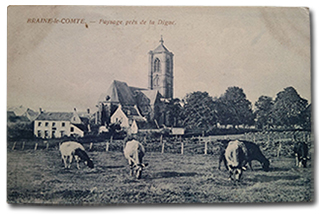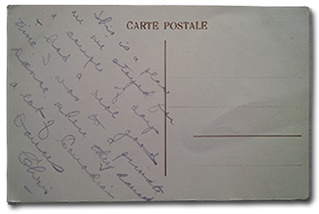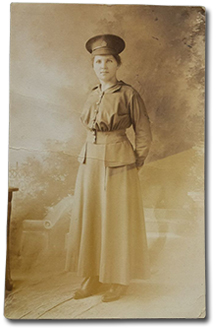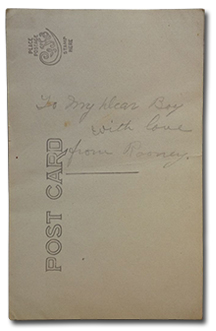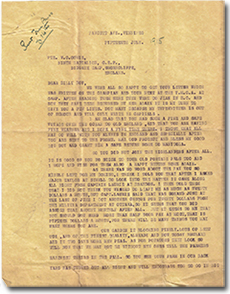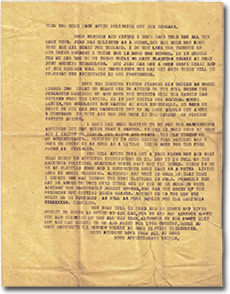The 100th anniversary of the First World War is now finished but the records will continue to be preserved at the Archives and accessible to current and future generations who want to know more about the time period. In addition, this blog will remain on our website as an additional resource.
July 2015 Posts:
- 27 July: Vimy Ridge Pilgrimage
- 20 July: Postcards sent during the First World War
- 13 July: First World War Letters Online!
- 6 July: Political and Social Commentary in Letters from Home
27 July 2015
Vimy Ridge Pilgrimage
After the First World War, Hudson’s Bay Company (HBC) employees who served overseas returned to their jobs and their lives. In the years following the war, the HBC honoured these veterans in a number of ways, such as through plaques and memorials.
The HBC’s Bay Store in Winnipeg had an in-house staff newsletter called The Bayonet. In a 1936 issue of the newsletter, HBC’s Canadian Committee posted an advertisement for “a chance of a lifetime” for store employees who had served in the war. On July 26, 1936, King Edward VIII unveiled the Canadian National Vimy Memorial, honouring those who fought at Vimy Ridge on April 9-12, 1917. Around 8000 Canadians made the pilgrimage to Vimy to witness the ceremony – the largest single Dominion pilgrimage to a war memorial.
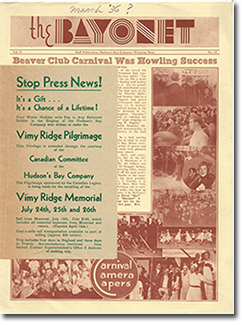
Hudson’s Bay Company Archives, Archives of Manitoba,
“The Bayonet” newsletter – File 1, The Bayonet, 1934-1938.
Advertisement on cover reads: “Stop Press News! It's a Gift… It's a Chance of a Lifetime! Four Weeks Holiday with Pay to Any Returned Soldier in the Employ of the Hudson's Bay Company who wishes to make the Vimy Ridge Pilgrimage. This Privilege is extended through the courtesy of the Canadian Committee of the Hudson's Bay Company. The Pilgrimage, sponsored by the Canadian Legion, is being made for the unveiling of the Vimy Ridge Memorial. July 24th, 25th, and 26th. Sail from Montreal, July 15th. Cost $160, which includes all essential expenses, from Montreal and return. (Payable April 15th.) Cent-a-mile rail transportation available to port of sailing (approx. $30 return). Trip includes four days in England and three days in France. Accommodation restricted… time limited. Contact Superintendent's Office if desirous of making trip.”
That spring, the Canadian Committee granted all veterans in the HBC employ a special leave of absence with full pay to take part in this pilgrimage. Fifteen employees from across Canada took up the offer, including five from the Winnipeg store. Another undated spring 1936 issue of the Bayonet ran a photo of four of these Winnipeg employees: Sam Agnew, Jack E. Bale, W.A.V. Pearce, and A.S. Ogilvy.
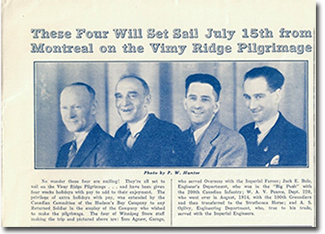
Hudson’s Bay Company Archives, Archives of Manitoba,
“The Bayonet” newsletter – File 1, The Bayonet, 1934-1938.
Search Tip: Use keyword “newsletter” to search Keystone for more staff publications from The Bay stores across Canada.
Feedback (0)
E-mail us at archiveswebmaster@gov.mb.ca with a comment about this blog post. Your comments may be included on this page.
20 July 2015
Postcards sent during the First World War
The Archives of Manitoba recently acquired two albums of postcards that were collected by Rooney Halldorson Linekar from approximately 1906 to 1930. The collection contains many postcards sent to Rooney by friends and family within Manitoba, but also includes postcards sent by soldiers serving overseas during the First World War, including her brother, Chris Halldorson, who later became an MLA and her future husband, Jim Linekar. Postcards were a quick, informal way of keeping in touch 100 years ago. Soldiers sent such postcards from European destinations to give their families and friends a visual idea of the faraway places the war took them.
This first postcard was sent by Rooney’s brother, Chris. Postcards weren’t always sent as postcards – sometimes they were sent in an envelope, possibly accompanying a letter.
Archives of Manitoba, Rooney Halldorson Linekar fonds, postcard #418, P7474/3.
Personal photographs could be made into postcards, such as this one of Rooney, herself. The message on the back suggests that she may have sent it to her future husband, Jim Linekar, who served overseas during the First World War.
Archives of Manitoba, Rooney Halldorson Linekar fonds, postcard #441, P7474/4.
There were also a variety of commercially produced postcards which depicted various sentiments, such as this patriotic postcard sent to Rooney from Private Teddy Johnson when he was stationed in England with the 27th Battalion, Canadian Army.
Archives of Manitoba, Rooney Halldorson Linekar fonds, postcard #421, P7474/3.
Search Tip: Search “Rooney Halldorson Linekar” in Keystone to find out more about Linekar and the collection of postcards.
Feedback (0)
E-mail us at archiveswebmaster@gov.mb.ca with a comment about this blog post. Your comments may be included on this page.
13 July 2015
First World War Letters Online!
The Archives of Manitoba has prioritized some collections of letters for digitization as part of our focus on records from the First World War. These letters provide striking first-hand accounts of the war and the experiences of individual soldiers. We invite you to take some time to read these engaging accounts. Three collections of First World War letters are now online and can be read in their entirety through the Keystone database.
- Jack Winter Quelch’s letters are part of the Jack Winter Quelch fonds. Quelch was from Birtle, Manitoba. He enlisted in 1915 and served in England, France and Belgium. He survived the war.
- George Battershill’s letters are part of the Battershill family fonds and detail his experiences from enlistment to just before his being fatally wounded at Vimy Ridge in April 1917.
- Charles Douglas (Dick) Richardson was from Grenfell, Saskatchewan and wrote to his friend Edna Chapman in Ninga, Manitoba. These are part of the Edna Chapman Robson fonds. Dick was killed at Vimy Ridge on April 9, 1917.
To find the letters of these three soldiers:
- Search the Keystone database for the last name of one of the soldiers mentioned above and check off the box that says "digital copies”.
- Click on the listings record and view the scans at the bottom. Each represents a file of records; if there is more than one file of letters, you will need to view more than one listings record.
The Archives continues to scan more collections of First World War letters and will make them available on our website as they are completed.
Feedback (0)
E-mail us at archiveswebmaster@gov.mb.ca with a comment about this blog post. Your comments may be included on this page.
6 July 2015
Political and Social Commentary in Letters from Home
The letters of Winnipeg resident Isaac Cowie, Junior Chief Trader of the Hudson’s Bay Company, convey information regarding the political and social atmosphere of a specific area to family members serving overseas. His letters discuss the war, the family, the weather and crops, social tensions, and politics.
In the second page of his letter dated July 15, 1915, Cowie says, “You will after this get a Free Press now and again when there is anything interesting in it. Now it is full of the Manitoba political scandals which have not yet ended.” Cowie was referring to the construction scandal of the parliament buildings in Winnipeg.
He also discusses social issues and, for instance, mentions enlistment in several of his letters. He closes off this letter with a very strong opinion on the matter, saying,
“Now dear Bill be good and be brave and never forget to write as often as you can, for we are all anxious about you and thinking of you all the time, although we are proud that you are man enough to go and fight for your country, while so many contemptible skunks remain at home playing themselves.”
Hudson’s Bay Company Archives, Archives of Manitoba.
Isaac Cowie fonds. Isaac Cowie to William Cowie, 15 July 1915.
To view this letter and Cowie’s other records, visit the Hudson’s Bay Company Archives at the Archives of Manitoba.
To read more about the Cowie family letters, read our blog posts from 28 July 2014 and 29 December 2014.
Search Tip: Use keywords “Isaac Cowie” in Keystone to see descriptions of these records.
Feedback (0)
E-mail us at archiveswebmaster@gov.mb.ca with a comment about this blog post. Your comments may be included on this page.



